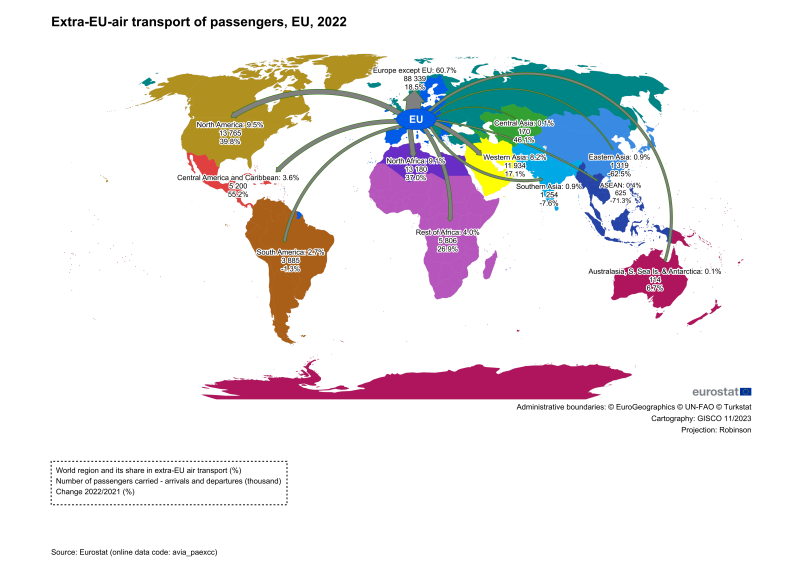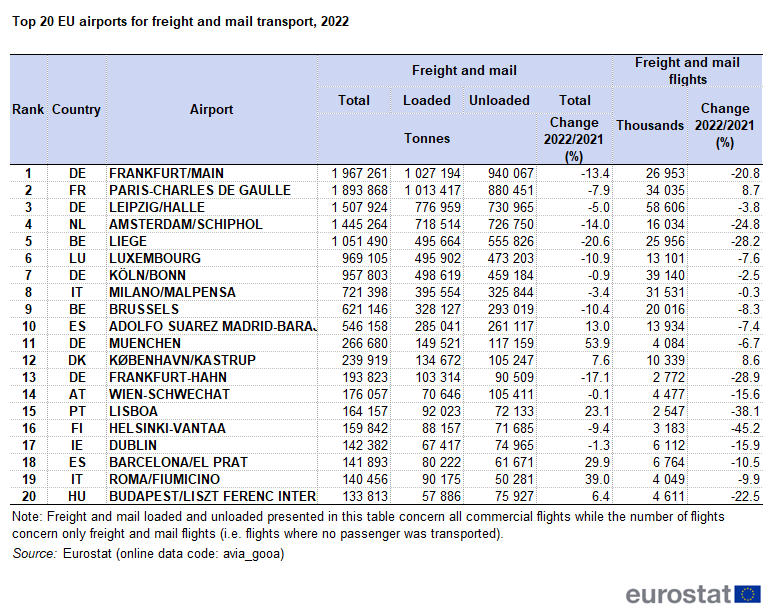Air transport statistics
Data extracted in November 2023.
Planned article update: 6 December 2024.
Highlights
Air passenger transport, 2022 (% change compared to previous year)
This article analyses recent data on air transport in the European Union (EU), both for passengers and freight and mail. It presents data on air passengers transported, showing the good recovery of the air traffic following the COVID-19 pandemic and its restrictions. The role of air transport in freight transport is less pronounced, as aircraft are an expensive transport mode in terms of tonne-kilometres and only competitive for longer distances and relatively light high-value or perishable goods.
The article distinguishes national (domestic), intra- and extra-EU transport, and also takes a look at the relative significance and ranking of airports.
Full article
Number of passengers transported by air increased to 820 million in 2022
To prevent the spread of the COVID-19 pandemic, countries around the world put in place a variety of restrictive measures from the beginning of 2020. The air transport industry was severely hit but the first signs of recovery were observed in 2021. In 2022, the signs of recovery in the aviation sector became even more pronounced, indicating a more pronounced and promising rebound where the total number of passengers travelling by air in the EU was 820 million, a substantial increase of 119.3 % compared with 2021 (Figure 1). All Member States registered an increase in the number of passengers carried by air transport compared with 2021. The highest increase was observed for Ireland (+256.2 %), followed by Finland (+203.3 %) and Slovakia (+202.5 %). Among the remaining EU Member States, 20 recorded an increase of more than 100 % (more than doubled) over the same period. The four remaining Member States registered an increase of more than 60 %, with the lowest increase observed for Cyprus (+68.9 %).
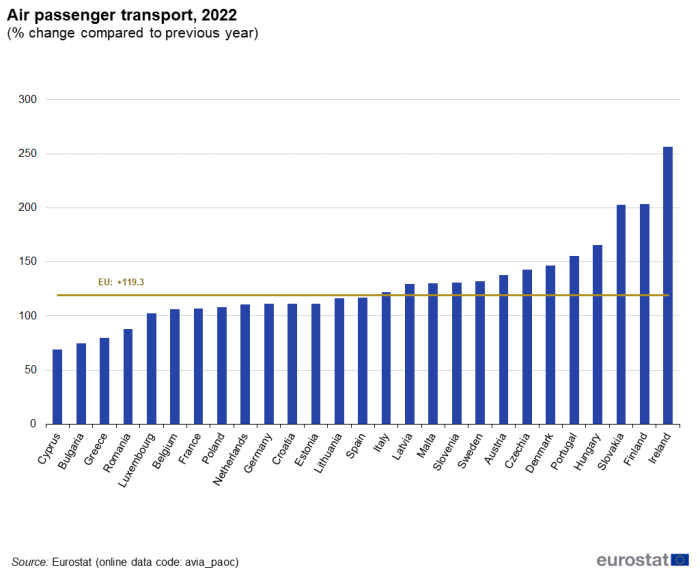
(% change compared with previous year)
Source: Eurostat (avia_paoc)
Figure 2 shows the year-on-year monthly and quarterly growth in air passenger transport for 2022 in the EU. The impact of the COVID-19 restrictions in 2021 is still clearly visible in the first and second quarters 2022, with dramatic increases of +357.9 % and +330.5 % in the number of passengers in the EU compared with the first and second quarters of 2021.The highest increase was registered in April 2022 with +549.8 %. In the third and fourth quarters, the number of air passengers carried also increased every month at EU level. The largest increase was observed in July 2022 (+93.7 % compared with the same month in 2021) followed by September 2022 and August 2022 with +66.2 % and +61.9 % respectively. The least impacted month was November, but still with an increase of 40.5 %.
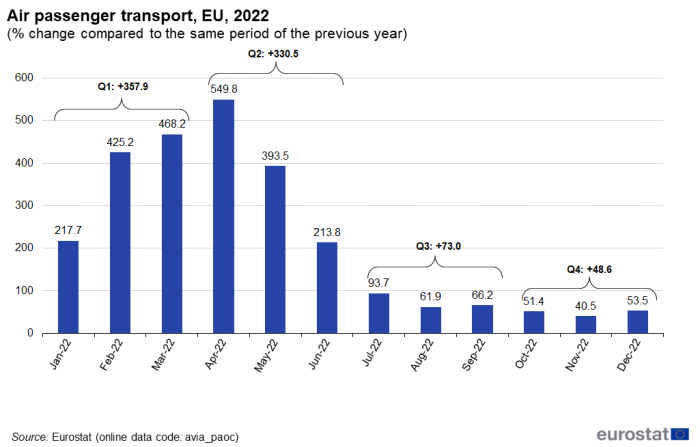
(% change compared with the same period of the previous year)
Source: Eurostat (avia_paoc)
Intra-EU passenger transport was almost at the same level as extra-EU traffic in 2022
Figure 3 indicates that the extra-EU transport represented 47.0 % of the total air passenger transport. It was the main origin/destination slightly ahead of intra-EU transport (36.5 %) and domestic transport (16.5 %). Compared with 2021, the share of national and intra-EU transport lost 6.5 percentage points (pp) and 1.3 pp respectively in 2022 to the benefit of extra-EU, which gained 7.8 pp.
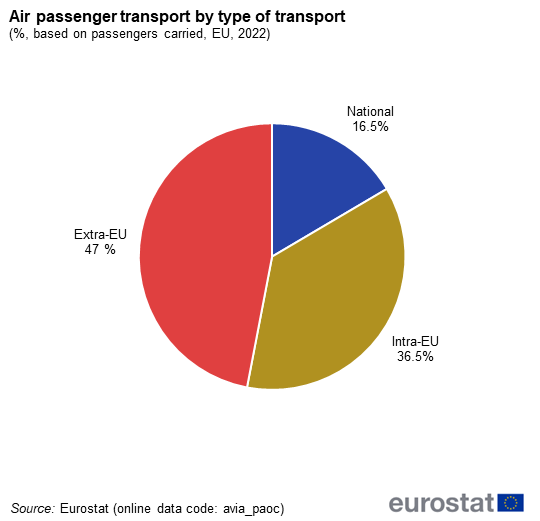
(%, based on passengers carried)
Source: Eurostat (avia_paoc)
All EU Member States registered an increase in intra-EU and extra-EU transport of passengers. For intra-EU transport, Spain carried the highest number of passengers in 2022 with 94 million passengers, but Finland recorded the highest increase with +231.4 %, reaching 8.6 million passengers. For extra-EU transport, Germany carried the highest number of passengers in 2022 with 64.9 million passengers, but Ireland increased the most with +317.2 %, reaching 15.6 million passengers. Among the other EU Member States, the lowest increase was registered for Cyprus in terms of extra-EU with +51.6 %, while Greece recorded the least increase for intra-EU traffic (+64.6 %). 22 out of the 27 Member States more than doubled in terms of extra-EU traffic, 19 for intra-EU traffic. With an increase of 225.5 %, Ireland registered the most growth in terms of national transport of passengers, with 122 644 passengers. Only two countries registered a drop in the domestic transport of passengers in 2022 compared with 2021, Hungary and Belgium with -89.3 % and -38.1 % respectively.

(passengers carried)
Source: Eurostat (avia_paoc)
Table 2 presents the top ten Member State-to-Member State flows registered in 2022. Among the top ten routes, Spain is involved in five, the most significant one being the traffic between Spain and Germany which represented more than 20 % of the top ten passenger routes and 4.2 % of all intra-EU transport. All routes showed a substantial increase between 2021 and 2022 from +45.8 % to +219.6 %.

(passengers carried)
Source: Eurostat (avia_paocc)
Map 1 gives an overall picture of the extra-EU market. Europe except EU was the main origin/destination of passengers travelling by air in 2022, with 59.1 % of the total extra-EU transport. The lowest shares were observed for Central Asia, and Australasia, S. Sea Is. & Antarctica (each at 0.1 %). Transport with all areas in the world increased substantially between 2021 and 2022. In relative terms, the highest increase was recorded for transport with South East Asian countries (ASEAN) (+612.4 %) while the lowest was for transport with Central America and Caribbean countries (+89.1 %).
Table 3 shows that Paris Charles de Gaulle predominated among EU airports, with the highest total of passengers transported by air in 2022 (57.5 million passengers). It was followed by Amsterdam Schiphol (52.5 million), Madrid Barajas (49.8 million), Frankfurt Main (48.8 million), Barcelona El Prat (41.2 million), the only airports registering over 40 million passengers.
The number of passengers increased in all top EU airports in 2022 compared with 2021, ranging between +51.8 % in Larnaka and +236.3 % in Dublin. Of the 41 top EU airports, 31 more than doubled their number of passengers carried between 2021 and 2022. The same trend is observed in terms of the number of passenger flights that also increased in all airports in 2022 compared with 2021, ranging between +34.4 % in Athinai Elefetherios-Venizelos and +156.9 % in Dublin.
Map 2 presents the top ten airport pairs within the EU. It is worth noting that eight routes out of ten were domestic ones. The connection with the highest number of passengers in 2022 was between the airports of Barcelona El Prat and Palma de Mallorca, with 2 033 205 passengers (+66.6 % compared with 2021). All routes registered substantial increases between 2021 and 2022, ranging between +31.8 % for the connection Paris-Orly and Nice-Côte d'Azur and +209.1 % for Lisboa and Madrid-Barajas.
Air freight and mail transport in the EU decreased by -7.9 % between 2021 and 2022
Total freight and mail transport in the EU increased by -7.9 % in 2022 compared with 2021 (Table 4). Domestic, intra and extra-EU transport all decreased, with increases of -7.4 %, -7.7 % and -7.9 %, respectively.
The evolution of freight and mail transport by air between 2021 and 2022 varies significantly at country level. It increased in 15 of the Member States, ranging from +1.1 % in Ireland to +40.81 % in Poland. By contrast, the highest decrease was registered by Latvia (-25.6 %), followed by Czechia (-20.9 %) and Belgium (-17.0 %). Six Member States recorded a decrease of more than 10 % while four recorded an increase of more than 10 %.
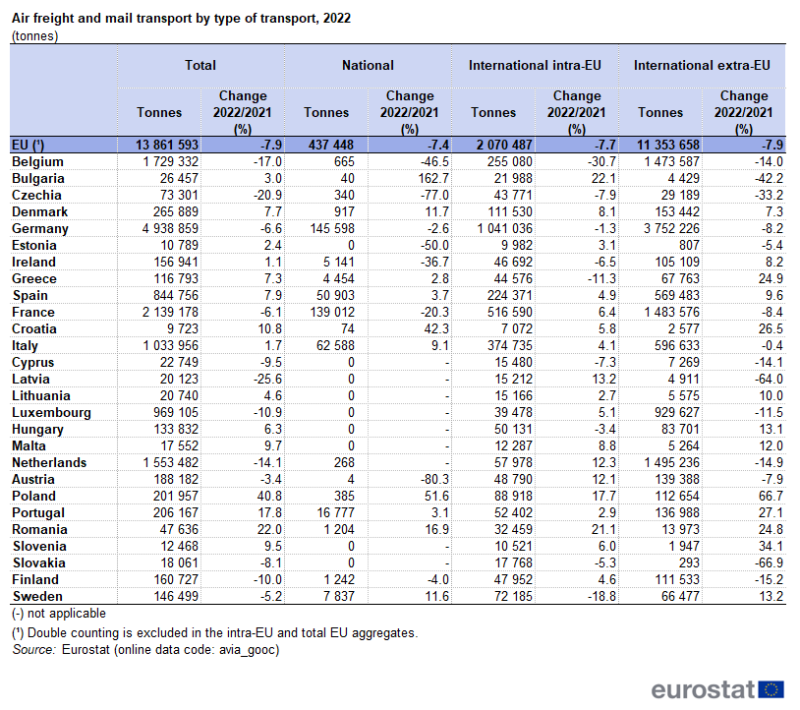
(tonnes)
Source: Eurostat (avia_gooc)
In 2022, Frankfurt Main was the main EU airport in terms of tonnes of freight and mail loaded/unloaded, with 2.0 million tonnes (Table 5). Paris Charles de Gaulle, which is the largest EU airport in terms of passenger transport, came second with 1.9 million tonnes. Among the top 20 airports, only seven registered a growth between 2021 and 2022 in terms of total freight and mail loaded/unloaded. Muenchen recorded the highest increase (+53.9 %), followed by Roma Fiumicino (+39.0 %), Barcelona El Prat (+29.9 %) and Lisboa (+23.1 %). By contrast, Liège recorded the highest decrease (-20.6 %) between 2021 and 2022. The number of freight and mail flights increased in only two of the top 20 airports between 2021 and 2022.
For long distances over 2 000 km, 99 % of the total transport was extra-EU
Figure 4 presents freight and mail transport by type of transport and distance class. For long distances over 2 000 km, 99 % of the total transport was extra-EU in 2022, 2021 and 2012. For distances between 1 500 and 1 999 km, extra-EU transport represented 57 % of the total in 2022. In 2012, this share was 50 % and up to 66 % in 2021. Intra-EU transport of freight and mail was predominant in distances inferior to 1 500 km. In 2022, it represented 74 % of total transport in the 1 000 – 1 499 km distance class, 68 % in 500 – 999 km class and 48 % in 300 – 499 km class. When looking at distances lower than 300 km, intra-EU transport represented 56 % while national claimed 38 % of the total freight and mail on board.

Source: Eurostat (avia_goodis)
The impact of the COVID-19 pandemic is visible for passenger transport in 2021, with the share of number of passengers on board to/from extra-EU countries being below the levels of 2012 and 2022 for all distance classes, but most significantly for long distances over 2 000 km, from 83 % in 2011, 78 % in 2019 but 72 % in 2021. The recovery from the COVID-19 crisis is visible as shares observed in 2022 tend to be close to the shares observed in 2012. The national and intra-EU traffic benefited from this fall in 2021, with an increase in the share of national traffic on distance bands inferior to 1 000 km. National traffic was much higher for all distance bands compared with 2012 and 2022, in particular for 500 – 999 km distance band, where it represented 42 % of the total traffic in 2021, against 30 % and 31 % in 2012 and 2022. The share of intra-EU traffic was more important in all distance bands greater than 1 000 km in 2021 compared with 2012 and 2022. The situation was similar when comparing 2022 with 2012, but with shares observed in 2022 that starts to be close to the ones observed in 2012.

Source: Eurostat (avia_paodis)
Air transport in EFTA and candidate countries also increased substantially between 2020 and 2021
All EFTA and candidate countries recorded increases of at least +52.1 % in terms of passengers transported (Table 6). Iceland was the most impacted country with a 165.2 % increase. The evolution of freight and mail transport by air between 2021 and 2022 decreased in all countries, with the exception of one, with changes ranking from -13.3 % in North Macedonia to +6.7 % in Switzerland.

Source: Eurostat (avia_paoc) Eurostat (avia_gooc)
Map 3 gives a picture of the air passenger transport between EFTA/candidate countries and the EU. The air passenger transport between North Macedonia and the EU represented 65.5 % of the total air passenger transport of the country. This was the highest share recorded among the EFTA and candidate countries. The lowest share was observed for Türkiye (27.9 %).
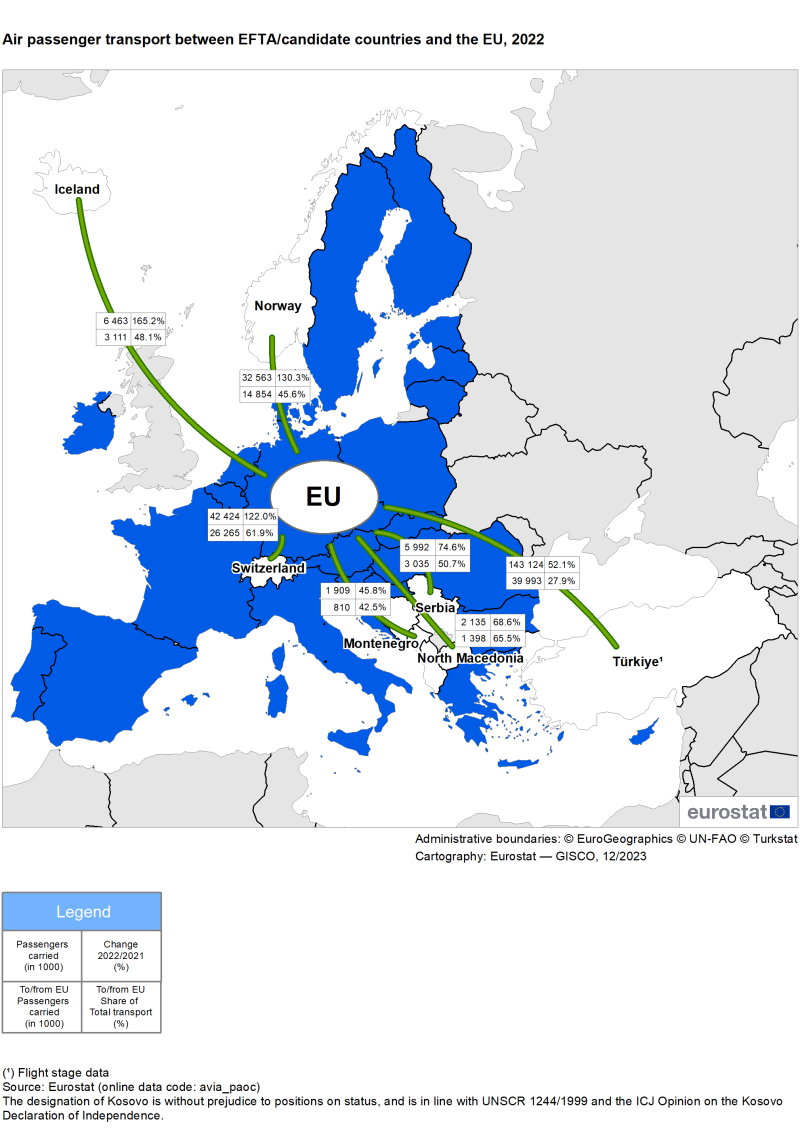
Source: Eurostat (avia_paoc)
Source data for tables and graphs
Data sources
More recent passenger data are available in the Eurostat database for a number of countries, as due to the importance of aviation in measuring recovery from the COVID-19 crisis, Eurostat is encouraging reporting countries to provide statistics on passenger transported by air in advance of the regulatory deadline. For some countries the data are available already up to 3 months after the end of a reference month.
Main definitions
The definitions used for air transport statistics are included in Regulation (EC) No 1358/2003 of 31 July 2003 implementing Regulation (EC) No 437/2003 of 27 February 2003 on statistical returns in respect of the carriage of passengers, freight and mail by air. The main definitions are the following:
- On Flight Origin and Destination (OFOD):
Traffic on a commercial air service identified by a unique flight number subdivided by airport pairs in accordance with the point of embarkation and point of disembarkation on that flight. This is linked to the definition of passengers carried.
- Passengers carried:
All passengers on a particular flight counted once only and not repeatedly on each individual stage of that flight. This excludes direct transit passengers.
- Freight and mail loaded/unloaded:
All freight and mail loaded onto or unloaded from an aircraft. This excludes direct transit freight and mail. In principle, information provided in this article is based on On Flight Origin/Destination (OFOD) data. Only when OFOD data have not been reported have airport declarations been used.
- Airport coverage:
In principle, this article covers air transport to and from any airports in the reporting countries with more than 150 000 passengers annually.
Notes on some reporting countries
- Türkiye: only provides flight stage data (Dataset A1) (in which there is no information on passenger carried and freight and mail loaded/unloaded) and airport declarations (Dataset C1) in which the partner airport is not provided. National and international transport cannot be calculated.
Double counting: the national aggregates and total intra-EU aggregates exclude any double counting. It includes all the departures figures reported plus "a part of" arrivals declarations, "a part of" including those arrivals declarations for which the corresponding departures declarations of the partner airport are missing.
Table 1: the figures (and related shares) for the country-country flows have been calculated by excluding the double counting at country-to-country route level. The figures are derived from table avia_paocc; the double counting for identical routes is excluded in order to obtain the correct total for country pairs. The data can be extracted from the aviation domain of the Eurostat on-line database or obtained upon request.
Map 1: the component countries comprising the world regions as defined for this map are based on the geonomenclature used by Eurostat for external trade statistics. The components of each world region can be extracted from the aviation domain of the Eurostat on-line database or obtained upon request. Some care should be taken in drawing conclusions as regards world regional shares due to the fact that passengers who either stop-over or change planes en-route will be allocated to the country in which they made their connections and not to the country of first origin or final destination.
Map 2: the total figures for each pair of airports have been calculated by adding together the 'Departures' declarations of the two airports concerned.
Map 3: the share of total transport represents, for each candidate country and each EFTA country, the share of total transport to/from EU countries. As indicated under the maps, transport to/from EU countries is sometimes estimated on the basis of mirror EU declarations.
In this article
- ":" means "not available"
- "-" means "not applicable"
- "0n" means "less than half the unit used"
- "0" means real zero
Context
All figures presented in this article have been extracted from the Eurostat aviation database. The database is available online from the Eurostat web page.
Direct access to
- Air transport (t_avia)
- Air transport of passengers (ttr00012)
- Air transport of goods (ttr00011)
- Air transport (avia)
- Air transport measurement - passengers (avia_pa)
- Detailed air passenger transport by reporting country and routes (avia_par)
- Air transport measurement - freight and mail (avia_go)
- Air transport measurement - passengers (avia_pa)
- Passenger and freight transport by air/Traffic data/Air transport at regional level (ESMS metadata file - avia_pa_esms)
- Reference Manual on Air Transport Statistics - Version 14 (Methodological manual)
- Illustrated Glossary for Transport Statistics 4th Edition
- Regulation (EC) No 1358/2003 of 31 July 2003 implementing Regulation (EC) No 437/2003 of 27 February 2003 on statistical returns in respect of the carriage of passengers, freight and mail by air.
